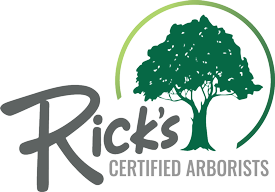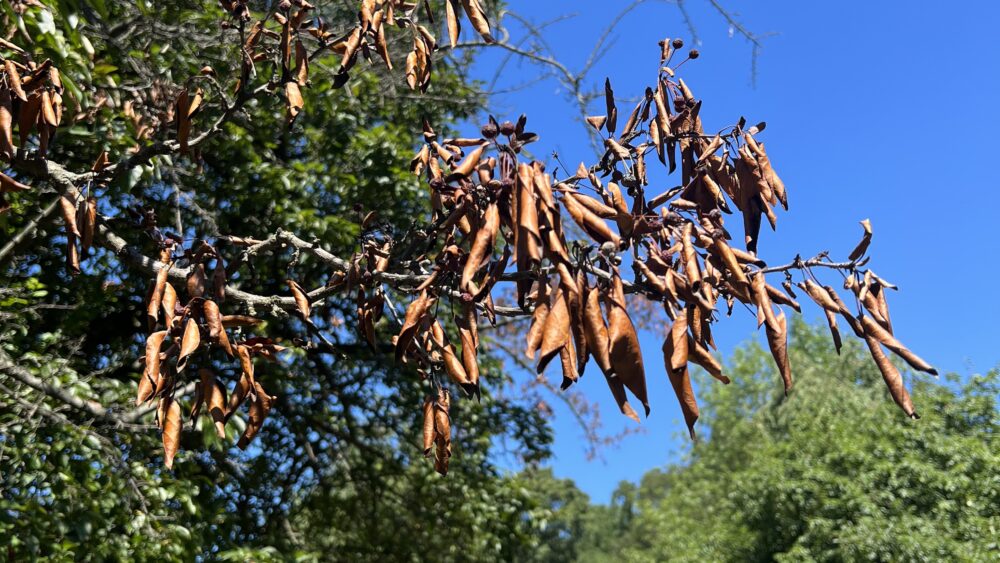If your trees exhibit dark patches on their leaves and weeping trunks, you may be dealing with a case of Fire Blight. Call Rick’s PHC Certified Arborists at 610-840-2655 to have your trees diagnosed and find out about treatment options.
What is Fire Blight?
Fire Blight is a pernicious bacterial tree disease affecting members of the Rose family. These trees and shrubs include but are not limited to Rose, Apple, Pear, Spirea, Mountain Ash, and Hawthorn.
Infection with the bacteria Erwinia amylovora causes the disease. The foliar disease is especially dangerous to fruit trees from the Rose family and can interfere with fruit, blossoms, trunks, and limbs.
The disease spreads easily in humid, rainy weather at the beginning of the growing season. It takes its name from the appearance of infected leaves, which look burnt and dead.
Fire Blight overwinters in the cankers on affected plants. In the warmer months, it spreads due to animal and insect activity and wet weather.
Symptoms
The following are the most common symptoms of Fire Blight:
- Discolored, wet bark cankers
- Seeping wounds
- A cream-colored liquid that oozes from the cankers in wet weather
- Tree branches are dead or drooping (commonly described as appearing like a “shepherd’s crook”)
- Brown, decaying fruit and flowers
- Dead fruiting spurs on tree branches
If you have noticed any of these symptoms, call a Certified Arborist right away to have your trees diagnosed. Quick treatment can control the bacteria’s spread and keep healthy trees from contracting the infection.
Treatment
Unfortunately, Fire Blight is not curable, but you can control it with a Certified Arborist’s help. Controlling Fire Blight involves using antibacterial sprays and pruning.
Commonly, arborists use a spray called Bordeaux mixture. This mixture combines copper sulfate, water, and lime (calcium hydroxide). They apply the spray in the winter before the buds open. They will spray the trees regularly throughout the year. Other antibacterial sprays and copper sprays can also be useful.
Pruning is crucial in treating Fire Blight. All damaged branches and foliage will need removal. Disinfect the tools in between each cut to avoid spreading the bacteria.
In addition to pruning and spraying, practice good hygiene methods around your affected trees. Please pick up all diseased fruit and branches from the ground and throw them away in the trash. Do not compost them because the bacteria will grow.
Prevention
Planting Fire Blight-resistant varieties is the most effective way to prevent the disease from affecting your landscape. Blight-resistant Apple varieties include Jonafree, Melrose, Red Delicious, and Goldrush. Blight-resistant Pears include Moonglow, Honeysweet, and Blake’s Pride.
Are You a Good Candidate for Fire Blight Treatment?
If you have trees in the Rose family, Fire Blight can damage them heavily. Aggressive treatment can help to contain the spread of the disease to your healthy trees. If you treat your trees promptly, you will protect your investment and the beauty of your landscape.
Why Choose Rick’s PHC Certified Arborists?
Our expert Certified Arborists can accurately diagnose tree and shrub diseases and recommend the best course of treatment. We specialize in tree wellness and have studied many problems that could interfere with your trees’ beauty.
Frequently Asked Questions About Fire Blight
Here are several selected questions from homeowners:
Is Fire Blight curable?
It is not curable, but arborists can control it using proper care techniques. Unfortunately, many trees with advanced cases of Fire Blight will need cutting down.
Does Fire Blight spread easily?
Fire Blight spreads very easily among susceptible trees. Rainfall can splash bacteria from one tree to another, especially in heavy rain and wind. Irrigating trees with a spray can spread the bacteria as well.
Can I manage Fire Blight myself?
Treating Fire Blight is complex. Professional help from a Certified Arborist will more effectively treat your trees with Fire Blight.
Can Fire Blight spread to trees outside the Rose family?
Luckily, it is limited to members of the Rose family. It can easily spread between different species within this family.
Should I fertilize trees with Fire Blight?
If you use a fertilizer with excess nitrogen, the resulting new growth will be very susceptible to Fire Blight. A tree care specialist can help you determine which fertilizer to use and when.
Call Rick’s PHC Certified Arborists
Call Rick’s PHC Certified Arborists at 610-840-2655 to discover how we can help you control Fire Blight in your home landscape. While Fire Blight is not curable, we can contain its impact on your trees.


Comments are closed.